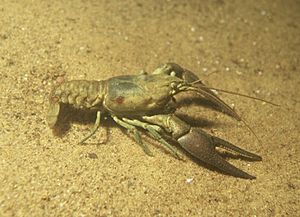Benton county cave crayfish facts for kids
Quick facts for kids Benton county cave crayfish |
|
|---|---|
 |
|
| Conservation status | |
| Scientific classification | |
| Kingdom: | |
| Phylum: | |
| Subphylum: | |
| Class: | |
| Order: | |
| Family: |
Cambaridae
|
| Genus: |
Cambarus
|
| Species: |
C. aculabrum
|
| Binomial name | |
| Cambarus aculabrum Hobbs & Brown, 1987
|
|
The Benton cave crayfish (Cambarus aculabrum) is a very rare type of crayfish. It lives only in Arkansas, United States. This special crayfish is found in just four places. Because it is so rare, the United States government lists it as an endangered species. This means it is in danger of disappearing forever.
Contents
About the Benton Cave Crayfish
What Does It Look Like?
This crayfish was first discovered in 1987. It grows to be about 48 millimeters (1.8 inches) long. That's about the length of a golf tee!
The Benton cave crayfish is a troglobite. This is a fancy word for an animal that lives its whole life in dark caves. Because it lives in darkness, it doesn't need color. So, it is white! It also has very tiny, simple eyes that don't work well. Scientists have found that its genes are different from other cave crayfish.
Where Does It Live?
This crayfish lives in four caves in northern Arkansas. Three of these caves are in Benton County. One cave is in Washington County.
Even though it's mostly found in Arkansas, it's not considered an "Arkansas endemic." This is because part of one cave where it lives actually goes into Missouri. However, no Benton cave crayfish have been found in Missouri yet.
What Does It Eat?
The Benton cave crayfish eats things that wash into the cave from the outside. This includes bits of plants and other organic matter. It also eats bat guano, which is bat droppings.
Sometimes, a fish called the banded sculpin eats this crayfish. Not much else is known about how it lives in its cave home.
Why Is It Endangered?
The Benton cave crayfish faces several dangers. One threat is people accidentally stepping on them. This can happen when cave explorers or trespassers go into their caves.
To help protect the crayfish, gates have been put at the cave entrances. But sometimes, people damage these gates.
The biggest danger to these crayfish is pollution of the groundwater. This is water that flows underground into the caves. If this water gets dirty, it harms the crayfish. This pollution was the main reason the crayfish was listed as endangered.
Sometimes, during big floods, the crayfish can be washed out of their caves. This can also cause them to die.


